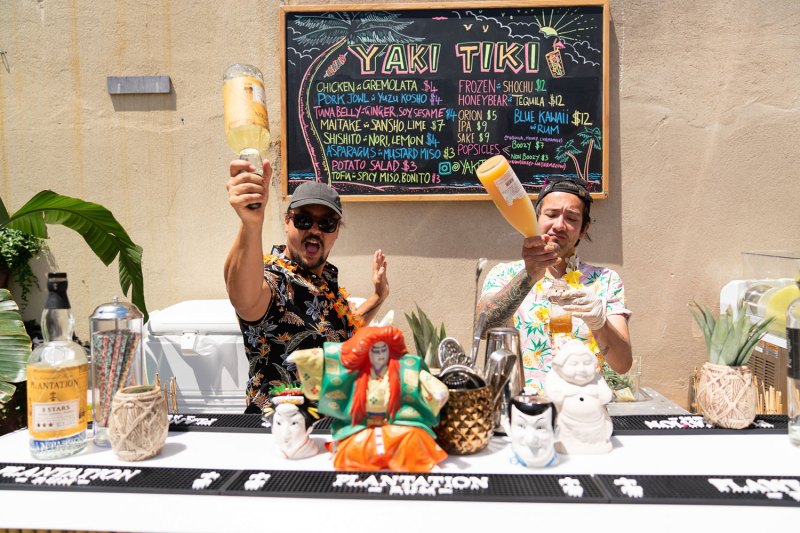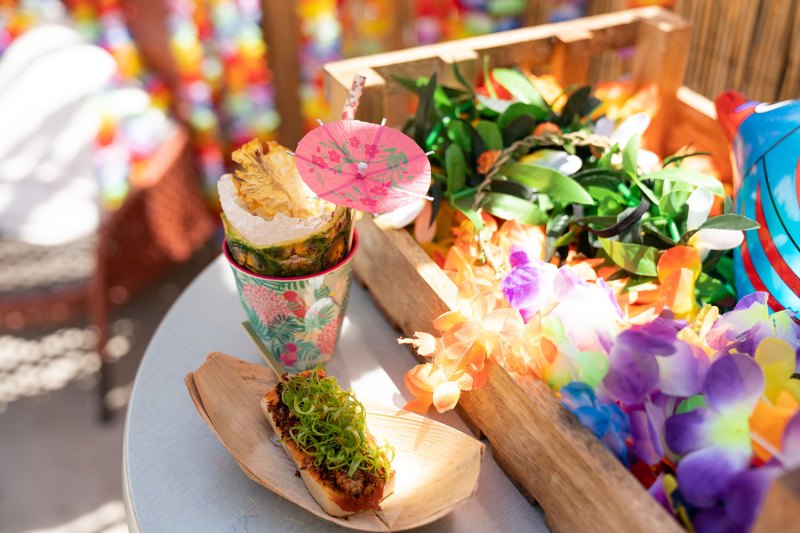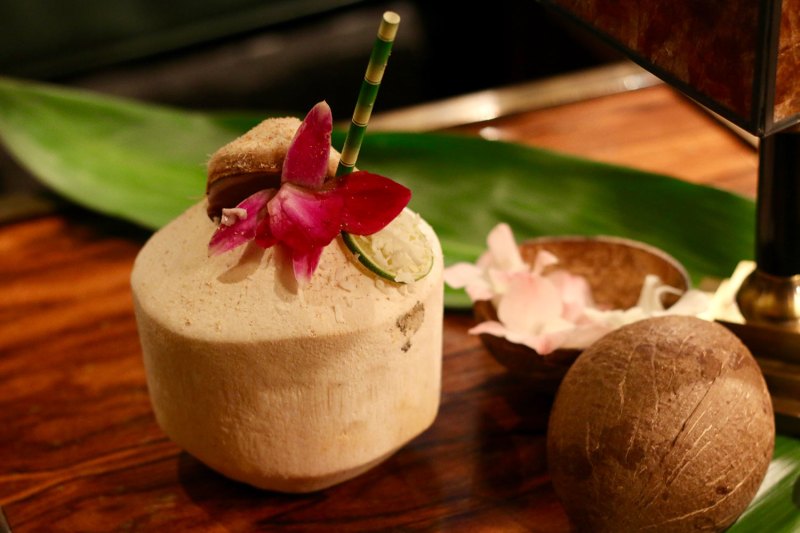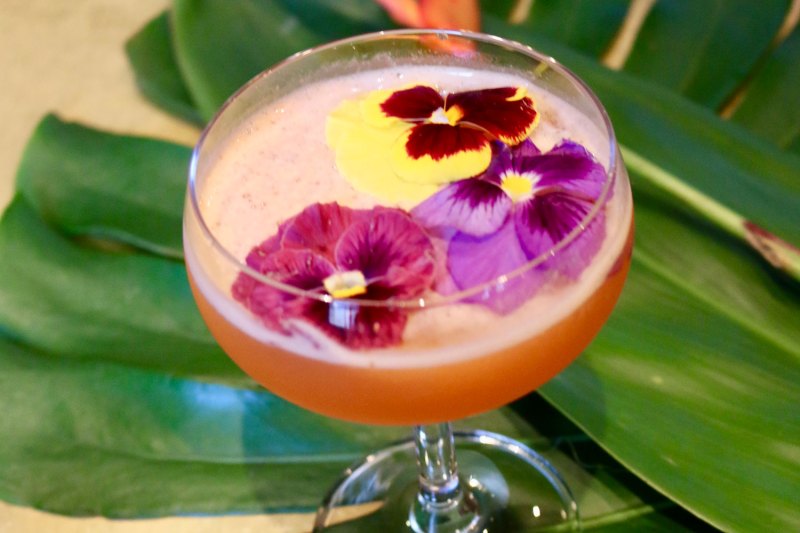Indulging in a strong, tropical cocktail is the ultimate form of escapism, whether you’re enjoying it at an authentic Tiki bar or making drinks for friends at home. Tiki garnishes are known for being elaborate and often over-the-top, which is one of the reasons these drinks are so fun to serve. To learn more about how to master the Tiki garnish, we chatted with bartenders Brian Evans and Yael Vengroff. Evans is the bar director at Sunday Hospitality and the brains behind one of our favorite summer pop-ups, Yaki Tiki. Vengroff oversees the beverage programs at Los Angeles favorites Winsome, Genghis Cohen, and The Spare Room, the latter of which hosts a yearly event called Evening of Tiki where guest bartenders team with Vengroff to serve their most over-the-top tropical creations. We chatted with both bartenders to get some expert tips on how to become a Tiki garnish master in your own right.
Transform Fruit Scraps Into Elaborate Garnishes
Bar waste is a real problem. For example, most establishments use citrus juice, but then toss the rest of the fruit if they have no use for the peel. But tiki drinks can benefit greatly from these so called scraps. “I like to utilize lime shells,” Vengroff says. “The shells can be used as boats to hold either floating booze (like in a Dark and Stormy), or [you can] add a sugar cube in the lime shell and set the shell on fire.”

While a pineapple slice perched on the rim of a glass is a no-brainer, Evans also makes use of the fronds and skin. “I really enjoy cutting the skin off in strips and lining the opening of a tiki mug to look like a collar — just make sure to clean the yeasts off of the skin first!” he says. “Also, pineapple slices work tremendously well and [are] visually striking when dehydrated as a garnish, then flame-torched to order.” On a recent Yaki Tiki visit, Evans garnished a frozen shochu drink with a fan of pineapple skin and fronds that looked like a mohawk of sorts.
Make Your Garnishes Come Alive
You’ve likely seen a banana dolphin balanced on the rim of a tiki drink, whether it was in a photo or in-person. Turning a garnish into a cute, edible character is always a fun way to serve a tropical drink, and it makes the libation extra photogenic. “One of the most recent and funny items I garnished a cocktail [with] was fresh passionfruit,” Vengroff says. “I sliced the passionfruit open halfway horizontally so it looked like Pacman with a mouth, and then scooped the insides of the passionfruit out and put googly eyes on it. It’s all about being fun and playful.”
Don’t Forget the Inedible Garnishes
We love it when our tiki drink comes with a snack, but the inedible garnishes are just as important. Branded stirring sticks used to be everywhere, and many people collected them as souvenirs to use at their home bars. While not every bar has jumped back on this bandwagon, some of our favorite tiki bars — like Pittsburgh’s Hidden Harbor with their branded sharks — are creating signature garnishes for their drinks. When you come across one, make sure to take it home, as it’s a great way to tell a story while you’re garnishing tiki

Cool cocktail picks are always a good garnish choice, as are those little colorful mermaids you can perch on the edge of the glass. At Yaki Tiki, a drink called the Blue Kawaii — a tasty mix of rum, blue curacao, mango, coconut, rice vinegar, yuzu and lime — is garnished with a tiny Japanese flag. Not only does it look awesome, but it nods to the origin of the ingredients featured in the drink.
Tiki Garnishes Should Transport the Drinker
Tiki is all about escapism. The movement was born in the Depression Era, but it gained mainstream popularity following WWII as servicemen returned home from the South Pacific with tropical shirts in tow. Things like plastic mermaids and elaborate fruit skewers certainly fit the bill, but simple garnishes that are thoughtfully done can have just as much of an impact. “It’s safe to say that it soothes guests’ expectations with the ‘more is more’ approach to decorating a drink, but even simpler garnishes like a lime wedge carved with a fruit zester or an edible flower can really achieve that wonderful ‘island get-away’ escapism,” Evans says.
When Garnishing a Drink, Put on a Show
Sitting at the bar is always a more exciting experience than a table because you get to watch the bartenders in action. This is especially true at a tiki establishment because so much goes into making each cocktail. And according to Evans, this display of showmanship can be part of the garnish experience. “I don’t necessarily have a formula in mind when designing a cocktail, but I do tend to geek out on the process and delivery,” he says. “It truly adds depth to the guest experience when they watch you strategically stack garnishes like a game of Jenga or light various garnish components on fire.”

Don’t hide in the kitchen when you’re entertaining and making tiki drinks for friends. Instead, set up your bar in a way that you can socialize and mix at the same time. That way, your guests will see the time and skill that goes into making and garnishing a drink, which will make the libation taste all the more special.
More is More, But Simplicity Works, Too
When it comes to tiki garnishes, there’s truly no right and wrong. In fact, it’s one time when the mantra “more is more” actually works quite well. But you don’t have to garnish a drink in a completely over-the-top way for it to be tiki. “You can also garnish something lightly, and it will still be beautiful,” Vengroff says. “I like to look at the color of the drink, what style it is and what glass it’s going in, and then make a decision based on that.”

Pay attention to the glassware, color of the cocktail, and ice used in the drink. For example, a tall, thin Collins glass will become top-heavy if your garnishes aren’t proportional. “Thinner garnishes are always better,” Vengroff says. “I hate to see big chunky pineapples and watermelons. But pay attention to your glassware because if you have a big chunky glass, then maybe a chunky piece of fruit might work.”
In the end, tiki garnishes are all about having fun. So use these expert tips as guidelines, but learn to follow your own tropical path when creating these fantastical drinks at home.



